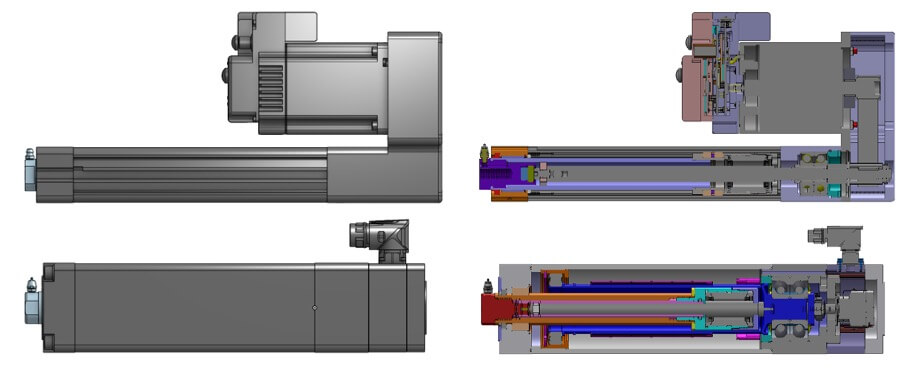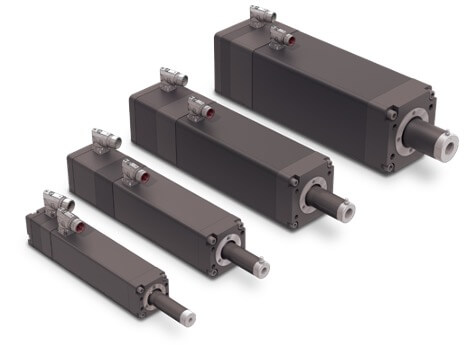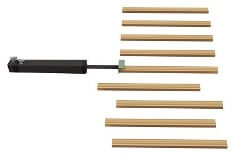Small yet beefy
By Ryan Klemetson on November 2, 2021
The big reason to consider an electric integrated servo actuator? It’s small.
Tolomatic defines a traditional rod actuator—the one with the motor outside—as a screw assembly driven by an external motor that is attached to the actuator by a coupler, belt or gearbox. The motor can be installed in inline or alongside of the actuator body (reverse parallel).

An integrated actuator, on the other hand, is a screw assembly rigidly coupled to and driven by an internal hollow-core servo motor. The mechanical actuator and servo motor are combined into a singular assembly. This single unit is then integrated with the servo drive and motion controller.
The reason for the compact design is the way the internal servo motor and screw assembly work together. The servo motor’s rotor and stator are built right into the housing. The nut (ball or roller) is connected to the thrust tube, which extends out and retracts right back through the motor. The motor windings spin and are connected to the back end of the screw shaft, which then drives the nut assembly with the thrust tube up and back and recessing it inside the motor.
The actuator is set up to communicate with a long list of drive suppliers through the use of various feedback devices, including ABB, Allen Bradley, Fanuc, Kollmorgen, Mitsubishi, Nidec, Rockwell, Siemens, and many others.
Advantages
An integrated actuator has the same feature sets and capabilities as traditional rod style actuators. In the case of the Tolomatic IMA, this means forces up to about 30 kN (7,000 lbf), including roller and ball screw options, anti-rotate, ingress protection, and optional motor brakes to name but a few. Here are some key advantages of integrated servo motor actuators (more details in our recent blog):

- Flexibility. Integrated actuators maintain mechanical form, fit and function regardless of the control system being used. This can provide further flexibility for multiple control schemes while avoiding the need to modify mechanical assemblies.
- Envelope. An integrated actuator has fewer components than a traditional actuator/motor combination. This allows for a smaller overall footprint and total weight. Add their lower centers of gravity, and integrated actuators are ideal for end-of-arm tooling and applications with sustained shock and/or vibration.
- Ingress protection. Fewer mechanical joints and fasteners allow for fewer potential ingress points.
- Efficiency and reliability. With fewer moving components than traditional actuators, integrated actuators provide the highest efficiency and reliability.
- Positional accuracy. Rigid motor connection provides superior positional accuracy and bi-directional repeatability.
- Acceleration and responsiveness. The connection between the motor and the mechanical system in an integrated actuator creates a stiff torque transmission system, resulting in increased dynamic response.
- Shock and vibration. Because of a low center of gravity that is closer to the mounting face, integrated actuators will typically have a higher tolerance to shock and vibration loads.
Applications
Integrated actuators are ideal for just about any application that would use traditional rodstyle actuators. These three application examples describe an integrated actuator used in a security barrier, aligning lumber on a conveyor and for applying tire tread.
Security barrier: Fast and immediate motion

Security barriers must move fast and on demand—even in the event of a power outage. Response speed is essential for this critical application often used by the defense, transportation and petrochemical industries as well as corporate facilities and airports. The compact design of an integrated actuator is ideal because it fits in the tight assembly located underneath the surface. The control systems for security lift gates are typically hydraulic, but the oil can cause operational and safety problems. Electric actuators remove that problem, as well as concerns about extreme weather, which also affects hydraulic performance. Although security gates can, at times, be low duty cycle operations, a roller screw design ensures the gates move fast and immediately when required.
Fence guide: Aligning lumber on a conveyor

The lumber processing industry historically relies on hydraulics for its motion control systems. We’re seeing more lumber processors switch to electric linear motion control for a variety of reasons. In this case, a lumber processor needed to improve the positioning of fencing bumpers that true up every board as it comes down a conveyor. The goal was more flexible positioning as well as reduced maintenance and contamination. The environment was prone to dust and debris, and the building was not climate-controlled. Ingress and temperature fluctuation also reduced performance.
Switching to an IMA33 integrated servo motor rod-style actuator gained the benefits the manufacturer needed. The ball screw provided flexible positioning capabilities (infinite fencing bumper positions) required to handle the variety of board lengths and board alignment with improved accuracy and repeatability. The electric actuator solution was significantly more efficient than incumbent hydraulic technology (~80% vs. 45%). Furthermore, the electric actuator solution was maintenance-free with no leaking fluids. Its seals are only used for ingress protection, not hydraulic fluid holding pressure. The IP67 rating protected the actuator from the moisture and dust present in the application.
Applying tire tread: Gaining consistent force and a digital fingerprint

The tire industry is a key growth industry that is also traditionally based in hydraulics but looking to make changes and upgrade equipment to improve productivity. A tire manufacturer relied on pneumatic motion control to apply tread to tire casings. However, the pneumatic system couldn’t hold an exact force, which caused defects and rejected product. In addition to the quality issue, the manufacturer wanted to record the forces being applied during the process.
To improve quality and data collection, the manufacturer switched from a pneumatic to electric system using integrated servo motor actuators. The actuator’s servo motor provided the consistent force required as well as a digital fingerprint of every press and how much force was applied.
Learn more! Compare traditional and integrated actuators. Download our white paper.
Connect with a Tolomatic engineers to discuss how integrated servo motor actuators work in your application. Contact a Tolomatic engineer today!

 Ask an Engineer
Ask an Engineer